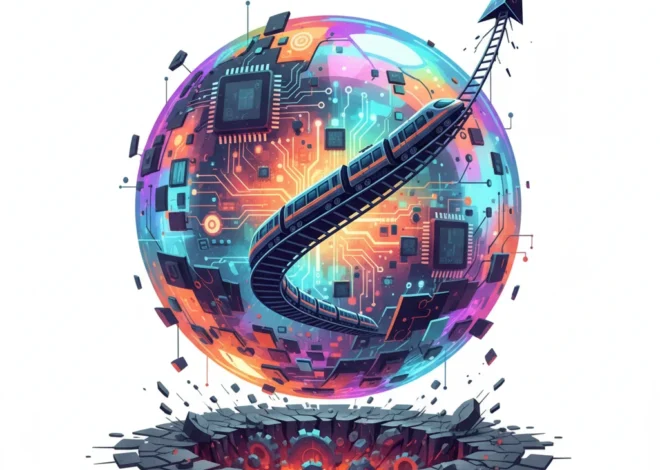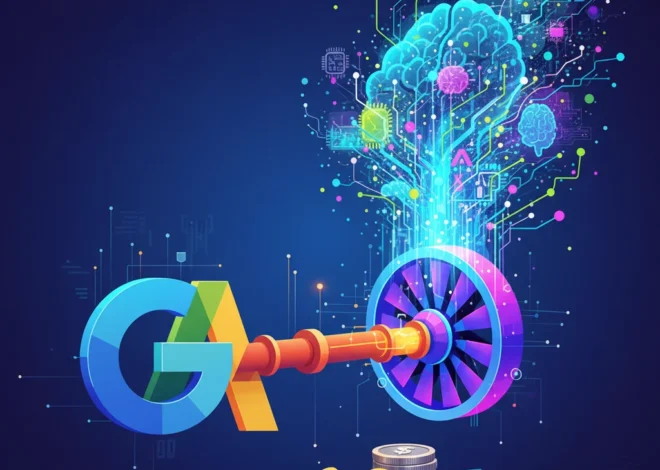
The AI Gold Rush: How to Find Gold Without Getting Caught in the Bubble
It’s impossible to ignore. The drumbeat of artificial intelligence grows louder every day. We see it in headlines about NVIDIA’s stratospheric stock market valuation, in the constant stream of new ChatGPT features, and in the breathless pronouncements that AI will change everything. And with this explosive growth comes the inevitable, whispered question: Are we in an AI bubble?
The signs are certainly there. Startups with little more than a pitch deck and an API call to OpenAI are raising millions. Tech stocks are soaring on the mere mention of an “AI strategy.” It all feels a bit familiar, doesn’t it? The echoes of the dot-com bubble of the late 1990s are ringing loud and clear for anyone who was paying attention back then.
But here’s the critical distinction, and the central theme we need to unpack: while the market’s froth and speculative fever might be a bubble, the underlying technology is not. The current AI boom is a classic case of a transformative technology wrapped in a layer of market hype. The challenge, as the Financial Times aptly puts it, is to avoid throwing the baby out with the bathwater. So, how do you—whether you’re a developer, an entrepreneur, or just a tech-savvy professional—navigate this gold rush to find the actual gold, without getting swept away by the hype?
The Ghost of Bubbles Past: Is This Dot-Com 2.0?
To understand the present, we must look to the past. The dot-com bubble was fueled by a revolutionary idea: the internet would connect the world and create entirely new economies. The thesis was correct, but the timing and valuation were wildly off. Investors poured money into companies like Pets.com and Webvan, businesses with flawed models that burned through cash with no path to profitability. When the bubble burst, it wiped out trillions in market value and left a scar on a generation of investors.
However, from those ashes rose the giants that define our modern digital world: Amazon, Google, and others who survived and thrived. The internet *did* change everything, just not in the way the most hyped-up companies of 1999 envisioned.
The AI boom shares some DNA with that era. There’s a similar “fear of missing out” driving investment, and many companies are being valued on pure potential rather than current performance. But there are crucial differences:
- Infrastructure is Mature: The dot-com boom was built on a nascent internet infrastructure with slow dial-up speeds. Today’s AI revolution is built on the back of a mature, hyperscale cloud computing ecosystem. The pipes are already laid, and they can handle the traffic.
- Real-World Applications & Revenue: Unlike many dot-com era startups, leading AI companies are generating substantial revenue. OpenAI’s ChatGPT and Microsoft’s Copilot aren’t just cool tech demos; they are powerful tools that millions of people and businesses are paying to use *right now*.
- Clear Productivity Gains: The promise of AI isn’t just about e-commerce or online ads. It’s about fundamental gains in productivity and automation across every industry, from drug discovery and programming to customer service and cybersecurity.
The lesson from the dot-com era isn’t that new technology is a mirage. It’s that in the early days of a technological revolution, the market struggles to separate the enduring platforms from the fleeting gimmicks. The value is real, but it’s often mispriced and misplaced. History suggests that the biggest winners are often the ones providing the core infrastructure.
AI's 'Fried Chicken' Moment: Are We in a Bubble or a Revolution?
Deconstructing the AI Stack: Where’s the Real Value Hiding?
Not all AI companies are created equal. To understand where the durable value lies, it helps to think of the AI industry as a “stack” with three distinct layers. Each layer has different economics, competitive dynamics, and risks.
Layer 1: The “Picks and Shovels” (Infrastructure)
During the 1849 California Gold Rush, the people who made the most reliable fortunes weren’t the prospectors digging for gold, but the merchants selling them picks, shovels, and blue jeans. In the AI gold rush, the “picks and shovels” are the companies providing the fundamental hardware and cloud infrastructure. Think NVIDIA (the undisputed king of AI chips), AMD, and the major cloud providers like Amazon Web Services, Microsoft Azure, and Google Cloud. They provide the raw computing power—the digital real estate—on which everything else is built. These companies are the first and most direct beneficiaries of the AI boom, as their products are essential for anyone doing serious work in machine learning.
Layer 2: The “Minds” (Foundation Models)
This layer is home to the creators of the large language models (LLMs) and other foundation models that power the current wave of generative AI. Companies like OpenAI (creators of GPT-4), Anthropic (Claude), and Google (Gemini) are in this category. They are engaged in an incredibly capital-intensive arms race to build the biggest and most capable models. While their technology is groundbreaking, their long-term business models are still evolving. They face immense compute costs and growing competition, making this a high-stakes game played by only a few well-funded players.
Layer 3: The “Hands” (The Application Layer)
This is the most crowded and dynamic layer. It consists of thousands of startups and established companies building applications on top of the foundation models. This includes everything from AI-powered copywriting assistants and code completion tools to sophisticated SaaS platforms for enterprise automation and threat detection in cybersecurity. The barrier to entry here is lower, but building a sustainable business is incredibly difficult. Many of these companies are thin “wrappers” around an OpenAI API, with little to no defensible moat. The winners in this space will be those who use AI to solve a specific, high-value customer problem and integrate it deeply into a workflow, rather than just offering a neat AI feature.
To clarify the differences, here is a breakdown of the AI stack’s layers and their characteristics:
| AI Stack Layer | Key Players | Capital Intensity | Competitive Moat | Investment Risk Profile |
|---|---|---|---|---|
| Layer 1: Infrastructure | NVIDIA, AWS, Microsoft Azure, Google Cloud | Extremely High | Very Strong (Scale, R&D, Network Effects) | Lower (Established, High Demand) |
| Layer 2: Foundation Models | OpenAI, Anthropic, Google, Mistral AI | Extremely High | Moderate (Talent, Data, Brand) | High (Intense R&D Race, High Burn Rate) |
| Layer 3: Applications | Thousands of SaaS companies & startups | Low to Moderate | Weak to Strong (Depends on Niche & Integration) | Very High (Crowded, Low Barriers to Entry) |
A Practical Playbook for the AI Revolution
So, how do we apply this understanding? The right strategy depends on who you are. The key is to look past the hype and focus on tangible value and sustainable growth.
For Developers and Tech Professionals
This is your moment. The demand for talent that can bridge the gap between AI models and real-world applications is exploding. Don’t just be a user of AI; become a builder.
- Master the Tools: Deepen your skills in programming languages like Python and learn the frameworks of machine learning (like TensorFlow or PyTorch).
- Think Beyond the API Call: Learn about prompt engineering, retrieval-augmented generation (RAG), and how to fine-tune models for specific use cases. This is where you create real value beyond a simple API wrapper.
- Focus on Integration: The most valuable skill is understanding how to embed AI into existing business processes and software to drive real efficiency. This is the core of enterprise automation.
For Entrepreneurs and Startups
The opportunity is massive, but so is the noise. Avoid the trap of being just another “AI company.”
- Solve a “Hair on Fire” Problem: Don’t lead with the technology. Lead with a deep understanding of a customer’s most urgent problem. Use AI as a tool to solve that problem 10x better than anyone else.
- Build a Defensible Moat: Your competitive advantage can’t just be that you use GPT-4. A real moat comes from proprietary data, a unique workflow integration, a strong community, or a trusted brand. As one analyst noted, many are just “renting their intelligence” from OpenAI, which is not a sustainable long-term strategy.
- Watch Your Unit Economics: AI is expensive. Every API call costs money. Ensure your pricing model and customer value proposition can support the high cost of computation. Profitability still matters.
For the Savvy Investor or Observer
The FT’s advice is sound: be discerning. The rising tide of AI hype may be lifting all boats, but many of them are full of holes.
- Watch Individual Valuations: Look at companies in the application layer with a critical eye. Are their revenue multiples justified? Do they have a clear path to profitability and a defensible market position?
- Consider the “Picks and Shovels”: Investing in the core infrastructure providers is often a safer, albeit less explosive, way to bet on the growth of the entire ecosystem.
- Look for “AI-Enabled” not just “AI-Powered”: The biggest long-term winners might be established, profitable companies (in fields from finance to manufacturing) that successfully use AI to enhance their existing products and operations, rather than pure-play AI startups.
When Hype Hits Reality: The Spectacular Misfire of a Peter Thiel-Backed AI Drone Startup
Conclusion: The Dawn of a New Era, Not the End of a Bubble
Yes, parts of the AI market are exhibiting bubble-like behavior. The hype is palpable, and some valuations are divorced from reality. A correction or a shakeout in the application layer is not just possible, but likely. That is the bathwater.
But the baby is the most significant technological platform shift since the internet and mobile computing. Artificial intelligence and machine learning will unlock staggering levels of productivity, create entirely new industries, and fundamentally reshape our world. This innovation is real, it’s powerful, and it’s just getting started.
The challenge is to maintain a long-term perspective. Don’t be swayed by the short-term market mania. Instead, focus on building and investing in real, durable value. Whether you’re writing code, building a company, or managing a portfolio, the winning strategy is the same: understand the fundamental layers of this new technological stack, separate the substance from the hype, and never forget that even in a gold rush, the goal is to find the gold, not just to get swept up in the frenzy.


